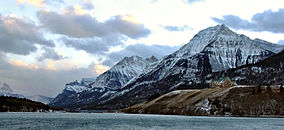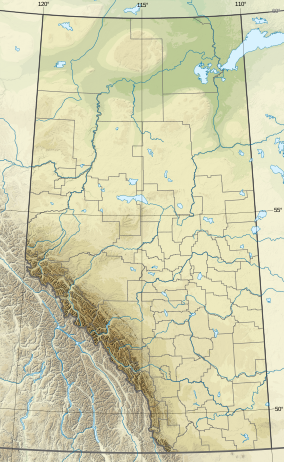
Back حديقة بحيرات واترتون الوطنية Arabic Voterton-Leyks Milli Parkı AZ Taman Nasional Danu Waterton BAN Уотъртън Лейкс (национален парк) Bulgarian Parc Nacional dels Llacs Waterton Catalan Waterton Lakes National Park Danish Waterton-Lakes-Nationalpark German Nacia Parko de Lagoj Waterton EO Parque nacional Waterton Lakes Spanish پارک ملی دریاچههای واترتون FA
| Waterton Lakes National Park | |
|---|---|
| Parc national des lacs-Waterton | |
 Upper Waterton Lake | |
| Location | Alberta, Canada |
| Nearest city | Pincher Creek |
| Coordinates | 49°02′45″N 113°54′55″W / 49.04583°N 113.91528°W |
| Area | 505 km2 (195 sq mi) |
| Established | 1895 (national park) 1979 (biosphere reserve) 1995 (World Heritage Site) |
| Visitors | 475,842 (in 2022–23[1]) |
| Governing body | I.D. Council, Parks Canada |

| |
| Part of | Waterton-Glacier International Peace Park |
| Criteria | Natural: vii, ix |
| Reference | 354 |
| Inscription | 1995 (19th Session) |
Waterton Lakes National Park is in the southwest corner of Alberta, Canada. The national park borders Glacier National Park in Montana, United States. Waterton was the fourth Canadian national park, formed in 1895 as Kootenay Lakes Forest Reserve. It is named after Waterton Lake, in turn after the Victorian naturalist and conservationist Charles Waterton. Its range is between the Rocky Mountains and the Prairies. This park contains 505 km2 (195 sq mi) of rugged mountains and wilderness. It has a diverse ecosystem.
Operated by Parks Canada, Waterton is open all year, but the main tourist season is during July and August. The only commercial facilities available within the park are located at the Waterton Park townsite. This park ranges in elevation from 1,290 metres (4,232 ft) at the townsite to 2,910 m (9,547 ft) at Mount Blakiston. It offers many scenic trails, including Crypt Lake trail. In 2012/2013, Waterton Lakes National Park had 402,542 visitors.[2]
The park is the subject of a short film in 2011's National Parks Project, directed by Peter Lynch and scored by Cadence Weapon, Laura Barrett and Mark Hamilton.[3]
- ^ Canada, Parks. "Parks Canada attendance 2022_23 - Parks Canada attendance 2022_23 - Open Government Portal". open.canada.ca. Retrieved 2024-05-07.
- ^ "Parks Canada Attendance 2007-08 to 2012-13" (PDF). Parks Canada. July 31, 2013. p. 2. Retrieved May 29, 2014.
- ^ "The Monday Q&A: Film director Peter Lynch". Retrieved 28 April 2020.

